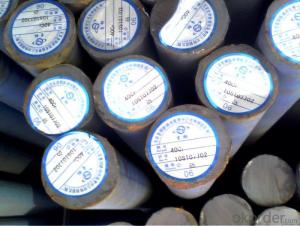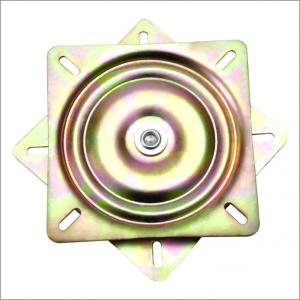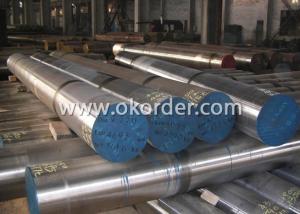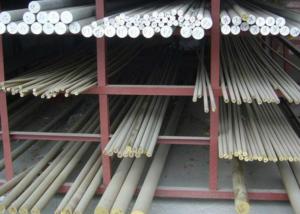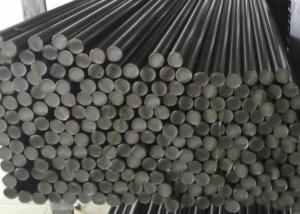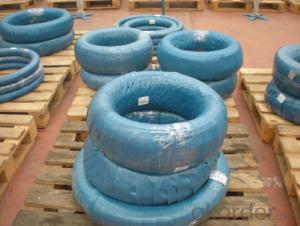Special Steel Alloy Steel Round Bar SCM415
- Loading Port:
- China main port
- Payment Terms:
- TT OR LC
- Min Order Qty:
- 30 m.t.
- Supply Capability:
- 10000 m.t./month
OKorder Service Pledge
OKorder Financial Service
You Might Also Like
Item specifice
Product Information
1 Standards and Chemical Composition:
GB | AISI | JIS | DIN |
15CrMo | SCM415 | 16CrMo44 |
C | Si | Mn | P | S | Cr | Mo |
0.13-0.18 | 0.15-0.35 | 0.60-0.85 | ≤0.03 | ≤0.03 | 0.9-1.2 | 0.15-0.30 |
2 Mechanical Property:
Yield Strength (MPa) | ≥295 |
Tensile Strength (MPa) | ≥440 |
Elongation (%) | ≥22 |
Hardness (HB) | ≤197 |
Reduction in Area (%) | ≥60 |
AKV (J) | ≥94 |
3 Brief Introduction:
Dimension | 14-350mm |
Length | 2-13m or as per your request |
Delivery condition | Hot rolled |
Heat Treatment | Normalizing, Annealing, Quenching |
Packing | Standard seaworthy packing or according to your requirements |
Product Show

Workshop Show

Shipping
1. FedEx/DHL/UPS/TNT for samples, Door-to-Door;
2. By Air or by Sea for batch goods, for FCL; Airport/ Port receiving;
3. Customers specifying freight forwarders or negotiable shipping methods!
Delivery Time: 3-7 days for samples; 5-25 days for batch goods.
Payment Terms
1.Payment: T/T, L/C, Western Union, MoneyGram,PayPal; 30% deposits; 70% balance before delivery.
2.MOQ: 1pcs
3.Warranty : 3 years
4.Package Informations: 1) EXPORT, In 20 feet (GW 25 ton) or 40 feet Container (GW 25 ton)
2)as customer's requirement
Why choose us?
(1) The leading exporter in China special steel industry.
(2) Large stocks for various sizes, fast delivery date.
(3) Good business relationship with China famous factories.
(4) More than 7 years steel exporting experience.
(5) Good after-sales service guarantee.
- Q:Can special steel be used in the production of fasteners for high-stress applications?
- Yes, special steel can be used in the production of fasteners for high-stress applications. Special steel alloys like stainless steel or alloy steel offer enhanced strength, durability, and resistance to corrosion, making them suitable for demanding applications where fasteners are subjected to high loads or harsh environments. These special steel fasteners help ensure a secure and reliable connection, even under extreme stress conditions.
- Q:How is special steel classified?
- Special steel is classified based on its chemical composition, physical properties, and intended use. It can be categorized into various types such as stainless steel, tool steel, alloy steel, and high-speed steel, each designed to meet specific requirements and applications in industries like automotive, aerospace, construction, and manufacturing.
- Q:What are the cost implications of using special steel?
- The cost implications of using special steel can vary depending on several factors. Special steel generally refers to alloyed or high-grade steel that offers enhanced properties such as improved strength, corrosion resistance, or heat resistance. One of the main cost implications is the higher initial cost of special steel compared to regular carbon steel. Special steel often requires more complex and expensive production processes, which can drive up the cost of raw materials. Additionally, the limited availability of certain alloying elements used in special steel can further increase its price. However, using special steel can also lead to cost savings in the long run. Its improved properties can result in reduced maintenance and replacement costs. For example, special steel that offers better corrosion resistance may require less frequent painting or coating, saving on maintenance expenses. Similarly, using high-strength special steel can allow for the use of lighter and thinner components, reducing material costs and transportation expenses. Furthermore, special steel's enhanced performance characteristics can lead to improved product quality and durability, which may result in higher customer satisfaction, increased sales, and potentially higher profits. In summary, while the initial cost of special steel is usually higher, its long-term benefits in terms of improved performance, reduced maintenance, and potential sales growth can offset these expenses, making it a cost-effective choice in many applications.
- Q:What are the characteristics of tool steel?
- Tool steel is a type of steel that possesses exceptional hardness, strength, and wear resistance, making it ideal for manufacturing various tools. It typically contains high levels of carbon, along with other alloying elements like chromium, vanadium, and tungsten. Tool steel also exhibits good toughness, heat resistance, and ability to retain sharpness. Additionally, it can be hardened and tempered to achieve desired properties for specific applications.
- Q:How does special steel contribute to the marine industry?
- Special steel plays a crucial role in the marine industry by offering exceptional strength, durability, and corrosion resistance, making it ideal for various marine applications. It is extensively used in the construction of ships, submarines, offshore platforms, and other marine structures, ensuring their structural integrity and safety. Additionally, special steel is used in manufacturing propellers and other critical components, enhancing efficiency and performance. Overall, special steel contributes significantly to the marine industry by providing reliable and high-quality materials that withstand harsh marine environments and support the growth and advancement of the sector.
- Q:Can special steel be used for making cutting tools?
- Indeed, cutting tools can be crafted from special steel. Specifically engineered and produced, special steel alloys like tool steel possess exceptional attributes such as wear resistance, hardness, toughness, and stability at high temperatures. Consequently, they are exceptionally suited for the production of cutting tools. These tools encompass a wide range of instruments, including saw blades, drills, milling cutters, knives, and other sharp-edged implements utilized across various industries such as manufacturing, construction, metalworking, woodworking, and more. The distinctive properties of special steel enable cutting tools to maintain their sharpness, withstand substantial cutting forces, and operate with utmost effectiveness and efficiency over extended durations.
- Q:How does special steel perform in terms of creep resistance at elevated temperatures?
- Special steel is renowned for its outstanding ability to withstand creep deformation at high temperatures. Creep refers to the gradual distortion of a material under constant stress over an extended period of time at elevated temperatures. Special steel, specially designed to endure high temperatures, possesses an impressive capacity to resist creep and retain its structural integrity. The extraordinary creep resistance of special steel is attributed to its distinctive composition, which incorporates various alloying elements like chromium, molybdenum, and vanadium. These alloying elements enhance the steel's strength at high temperatures, augment its resistance to deformation, and hinder the formation of detrimental changes in its microstructure that can occur during creep. Moreover, special steel undergoes specific heat treatment procedures such as quenching and tempering, which further enhance its resistance to creep deformation. These procedures refine the steel's microstructure, resulting in a material that is fine-grained and uniform, enabling it to endure deformation even when exposed to high temperatures for extended periods. The exceptional creep resistance of special steel makes it the preferred choice in various industries that operate under high-temperature conditions, including power generation, petrochemicals, and aerospace. It provides extended service life, reduced maintenance requirements, and enhanced safety in critical applications where failure due to creep deformation could have severe consequences. In conclusion, special steel demonstrates remarkable performance in terms of its ability to resist creep deformation at high temperatures. Its distinct composition, including alloying elements and specific heat treatment procedures, empowers it to withstand deformation and maintain its structural integrity even under prolonged exposure to elevated temperatures.
- Q:What are the common challenges in casting special steel?
- The casting of special steel comes with various challenges due to its unique properties and composition. Some common challenges associated with casting special steel include the following: 1. High melting point: Special steels often possess higher melting points compared to regular carbon steels. This necessitates the utilization of specialized equipment and techniques to achieve the required casting temperature. 2. Alloying elements: Special steels frequently contain alloying elements like chromium, nickel, molybdenum, or vanadium. These elements enhance the properties of the steel but can also complicate the casting process. Proper control and understanding of these alloying elements are crucial to ensure the desired mechanical properties in the final product. 3. Oxidation and decarburization: During the casting process, special steel is susceptible to oxidation and decarburization. The exposure to oxygen and high temperatures can lead to surface defects and carbon loss, which can compromise the strength and hardness of the steel. Precise control of casting parameters, such as atmosphere and mold design, is necessary to minimize these issues. 4. Shrinkage and porosity: Special steels often exhibit a higher shrinkage rate during solidification compared to regular steels. This can result in shrinkage defects and porosity within the castings. Appropriate gating and riser design, along with the use of suitable feeding systems, are critical to mitigating these issues and ensuring sound castings. 5. Thermal stresses: Special steels may display higher thermal expansion coefficients, leading to significant thermal stresses during cooling and solidification. These stresses can cause cracking and distortion in the castings. Proper design considerations, such as the use of chills or controlled cooling techniques, are essential to minimize thermal stress and maintain dimensional stability. 6. Machinability: Special steels, especially those with high alloy content, can be challenging to machine due to their hardness and toughness. Casting defects like inclusions, segregations, or non-uniform microstructure can further complicate the machining process. Appropriate selection of cutting tools and machining parameters is necessary to achieve the desired dimensional accuracy and surface finish. In conclusion, casting special steel presents a range of challenges related to high melting points, alloying elements, oxidation, shrinkage, porosity, thermal stresses, and machinability. Overcoming these challenges requires a comprehensive understanding of material properties, precise process control, and the implementation of suitable casting techniques.
- Q:What are the different heat treatment defects in special steel?
- During the heat treatment process of special steel, various defects can occur. Some of the most frequently encountered defects are as follows: 1. Decarburization: This defect arises when the steel's outer layers lose carbon due to exposure to high temperatures in an environment rich in oxygen. The consequence of decarburization is reduced hardness and strength in the treated steel. 2. Quench cracking: Also known as cracking during quenching, this defect emerges when the steel undergoes rapid cooling subsequent to heating. The differential cooling rates can induce internal stresses, resulting in cracks within the material. 3. Distortion: Distortion refers to alterations in the shape or dimensions of the steel during the heat treatment process. It can be caused by uneven heating or cooling, inadequate fixturing, or improper quenching techniques. 4. Soft spots: Soft spots are localized areas of reduced hardness in the treated steel. These spots can occur due to insufficient heating or improper quenching, leading to diminished mechanical strength in those regions. 5. Overheating: Overheating is a defect that occurs when the steel is subjected to excessively high temperatures during the heat treatment process. This can lead to grain growth, reduced toughness, and overall decreased material properties. 6. Case hardening problems: Special steels often undergo case hardening processes, such as carburizing or nitriding, to create a hardened outer layer. However, several defects can arise during these processes, including inadequate or excessive hardening, poor case depth, or uneven distribution of hardness. 7. Residual stresses: Residual stresses are internal stresses that persist in the steel after the heat treatment process. If not properly controlled, these stresses can cause dimensional instability, warping, or even cracking. To prevent or minimize these heat treatment defects, it is crucial to adhere to proper heat treatment procedures. This includes precise temperature control, appropriate cooling rates, and suitable fixturing techniques. Furthermore, the use of high-quality heat treatment equipment, close monitoring of the process, and thorough inspections can aid in detecting and rectifying any potential defects in special steel.
- Q:How does special steel contribute to the energy equipment industry?
- Special steel plays a crucial role in the energy equipment industry by providing materials with superior strength, durability, and corrosion resistance. These properties enable the production of high-performance components such as turbine blades, pressure vessels, and pipelines, which are essential for power generation, transmission, and distribution. Additionally, special steel's ability to withstand extreme temperatures and harsh operating conditions enhances the efficiency and reliability of energy equipment, ultimately contributing to the overall sustainability and advancement of the industry.
1. Manufacturer Overview |
|
|---|---|
| Location | |
| Year Established | |
| Annual Output Value | |
| Main Markets | |
| Company Certifications | |
2. Manufacturer Certificates |
|
|---|---|
| a) Certification Name | |
| Range | |
| Reference | |
| Validity Period | |
3. Manufacturer Capability |
|
|---|---|
| a)Trade Capacity | |
| Nearest Port | |
| Export Percentage | |
| No.of Employees in Trade Department | |
| Language Spoken: | |
| b)Factory Information | |
| Factory Size: | |
| No. of Production Lines | |
| Contract Manufacturing | |
| Product Price Range | |
Send your message to us
Special Steel Alloy Steel Round Bar SCM415
- Loading Port:
- China main port
- Payment Terms:
- TT OR LC
- Min Order Qty:
- 30 m.t.
- Supply Capability:
- 10000 m.t./month
OKorder Service Pledge
OKorder Financial Service
Similar products
New products
Hot products
Related keywords
